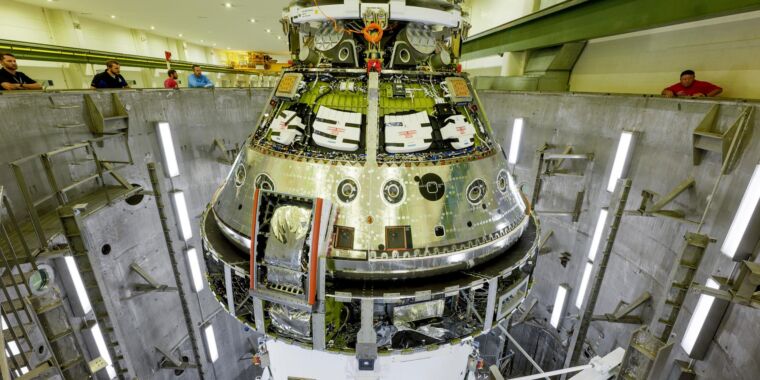NASA / Rad Sinyak
Now that NASA has resolved the question of the Starliner spacecraft and its two crew members on the International Space Station, the agency faces another high-stakes human spaceflight decision.
The choice concerns the Orion spacecraft’s heat shield and whether NASA will make any changes before the Artemis II mission that will make a lunar flyby. Although Starliner has garnered a lot of media attention, this will be an even higher-profile decision for NASA, with higher consequences—four astronauts will be on board, and hundreds of millions, if not billions of people, will be watching humanity’s first deep space mission in more than five decades.
The issue is the safety of the heat shield, located at the base of the capsule, which protects Orion’s crew during its return to Earth. During the Artemis I mission that sent Orion beyond the Moon in late 2022, without astronauts on board, chunks of charred material cracked and chipped away from Orion’s heat shield during reentry into Earth’s atmosphere. Once the spacecraft landed, engineers found more than 100 locations where the stresses of reentry damaged the heat shield.
After assessing the issue for more than a year, NASA convened an “independent review team” to conduct its analysis of NASA’s work. Initially, this review team’s work was due to be completed in June, but its deliberations continued throughout much of the summer, and it only recently concluded.
The team’s findings are not public yet, but NASA essentially faces two choices with the heat shield: It can fly Artemis II with a similar heat shield that Orion used on Artemis I, or the agency can revamp the design and construct a new heat shield, likely delaying Artemis II from its September 2025 launch date for multiple years.
What they’re saying
In recent comments, NASA officials have been relatively tight-lipped when asked how the heat shield issue will be resolved:
- NASA Administrator Bill Nelson, in an interview with Ars, in early August: “They are still deciding. I’m very confident [in a launch date of September 2025] unless there is the problem with the heat shield. Obviously, that would be a big hit. But I have no indication at this point that the final recommendation is going to be to go with another heat shield.”
- NASA Associate Administrator Jim Free, in conversation with Ars, in late August: “That’s on a good path right now.”
- NASA Associate Administrator for Exploration Systems Development, Catherine Koerner, in an interview with Ars in mid-August: “The entire trade space is open. But as far as the actual Artemis II mission, right now, we’re still holding to the September ’25 launch date, knowing that we still have a lot of work to do to close out the heat shield investigation.”
- NASA Deputy Associate Administrator for Moon to Mars Program Amit Kshatriya to the NASA Advisory Committee in late August: “The independent review team has just wrapped up their analysis, so I expect that to close out. We should have a disposition there in terms of how they incorporate those findings.”
In summary, the Independent Review Team’s work is done, and it has begun to brief NASA officials. A final decision will then be made by NASA’s senior leadership.
What happens now
In preparation for Artemis II, the Orion spacecraft underwent thermal and vacuum testing this year before it will be stacked onto the Space Launch System rocket. Initially, NASA planned to begin the stacking process this month but ultimately delayed this until there was clarity on the heat shield question. The shield is already attached to the spacecraft.
Most people Ars spoke to believe NASA will likely fly with the heat shield as is. Sources have indicated that NASA engineers believe the best way to preserve the heat shield during Artemis II is by changing its trajectory through Earth’s atmosphere.

The inspector general’s report May 1 included new images of Orion’s heat shield.
NASA Inspector General
During Artemis I, the spacecraft followed a “skip” reentry profile, in which Orion dipped into the atmosphere, skipped back into space, and then made a final descent into the atmosphere. This allowed for precise control over Orion’s splashdown location and reduced g-forces on the vehicle. There are other options, including a ballistic reentry, with a steeper trajectory that is harder on the crew in terms of gravitational forces, and a direct reentry, which involves a miniature skip.
A steeper trajectory would allow Orion’s heat shield to be exposed to atmospheric heating and air resistance for a shorter period of time. NASA engineers believe that the cracking issues observed during Artemis I were due to the duration of exposure to atmospheric heating. So less time—theoretically—means that there would be less damage observed during the reentry of Orion during Artemis II.

